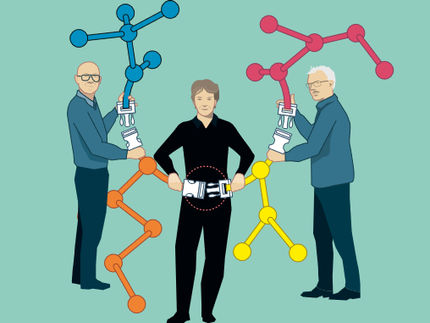Molecules Dress for Success
Suitanes: mechanically interlocked molecules
An enormous challenge to science is the generation of two individual molecules that are not chemically bound to each other but are mechanically wedged together to form a tight link. A team of British and American researchers have now developed a whole new family of such mutually interlocked molecules and generated a first example. The researchers have named these novel compounds "suitanes", based on their resemblance to a torso with two or more limbs that is completely enveloped in a one-piece "suit". The number of limbs is indicated by a number inserted into the name of the compound: A suit[2]ane has two limbs, a suit[3]ane has three limbs, and a suit[4]ane has four limbs. "A suit[5]ane looks like a doll wearing a one-piece romper enclosing all five limbs: two legs, two arms, and the head," explains J. Fraser Stoddart, a pioneer of supramolecular chemistry. The team headed by Stoddart (University of California, Los Angeles) and David J. Williams (Imperial College, London) have successfully synthesized the simplest representative of this class of compounds: a suit[2]ane. They first used computer simulations to develop a plan of attack. The inner molecule - the "body" - should be relatively stiff and oblong; the suit must be a flexible molecule that can be assembled around the body from a few individual components. Like a well-tailored suit, all of the individual components must be perfectly coordinated with each other regarding their shape, size, and functional groups. The researchers first produced a stiff, linear molecular framework: a slim center (a central aromatic ring) is hooked to two bulging "shoulders" (anthracene ring systems), each in turn attached to an "arm". Next, the molecule was dressed in its suit. The suit was put on piece by piece and "sewed" together in a final step: in a self-organization process, two large ring-shaped molecules (crown ethers) slipped like sleeves onto the molecular "arms". The torso, arms, and sleeves were chemically outfitted to provide strong interactions to hold the sleeves tightly in place. In the next step, another smaller type of molecule (aromatic ring) was added. These molecules each contained two groups of atoms (amino groups), located across from each other, designed to each enter into attractive interactions with one spot on each sleeve. In the final step, chemical bonds were formed at these four points of contact; the aromatic rings thus linked the two sleeves into a single large molecule that completely encloses the torso molecule without binding to it chemically. "Discovering the way to dress a molecule with another one is a prelude to constructing artificial systems reminiscent of the living cell," says Stoddart. Original publication: J. Fraser Stoddart et al.; "Suitanes"; Angewandte Chemie International Edition 2006, 45, No. 40,
Most read news
Topics
Organizations
Other news from the department science

Get the chemical industry in your inbox
By submitting this form you agree that LUMITOS AG will send you the newsletter(s) selected above by email. Your data will not be passed on to third parties. Your data will be stored and processed in accordance with our data protection regulations. LUMITOS may contact you by email for the purpose of advertising or market and opinion surveys. You can revoke your consent at any time without giving reasons to LUMITOS AG, Ernst-Augustin-Str. 2, 12489 Berlin, Germany or by e-mail at revoke@lumitos.com with effect for the future. In addition, each email contains a link to unsubscribe from the corresponding newsletter.
Most read news
More news from our other portals
Last viewed contents

LERG SA - Pustków, Poland

Topsoe Fuel Cell - Konigs Lyngby, Denmark

LIOT Kunststoff- u. Rohrleitungsbau GmbH - Dölsach, Austria

Schmitz Industrievertretung - Brüggen, Germany

MANN+HUMMEL GMBH - Speyer, Germany

ASI GmbH - Leipzig, Germany

A. + E. Fischer-Chemie GmbH & Co.KG - Wiesbaden, Germany


























































